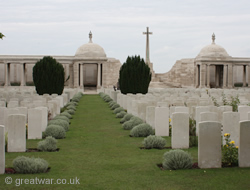Loos Memorial, Loos-en-Gohelle, France
The Loos Memorial commemorates 20,605 British officers and men who were killed from 25 September 1915 to the end of the war in November 1918 in the battle sector between the river Lys in French Flanders and the village of Grenay, near Lens, in Artois.
The Loos Memorial to the Missing forms the rear and the two sides of Dud Corner Cemetery. The thousands of names of the servicemen missing in action with no known grave are inscribed on 139 stone panels attached to these side and rear walls.
- Site for the Memorial Location
- The Missing of the Battle of Loos, 1915
- Design of the Memorial
- Unveiling of the Memorial
- Search for Names on the Loos Memorial
- Loos Memorial Location
Site for the Memorial Location
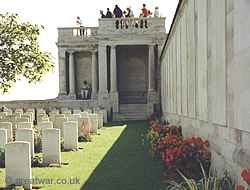
|
The site on which the memorial and cemetery were built is close to a strongpoint in the German Front Line of 25 September 1915. On British Army maps this strongpoint was called the “Lens Road Redoubt”. It was on the high ground to the west of Loos village, blocking access for the Allies to the built-up mining town of Lens along the main roadway of the Lens-Béthune road. A little to the north of this redoubt there was another German strongpoint located on the minor road from Loos to Vermelles. This redoubt was called the “Loos Road Redoubt” by the British Army.
A 1915 trench map (1) used by a British officer at the Battle of Loos in September-October 1915 shows the “Lens Road Redoubt” located on the 70 metre contour line, just below the crest of the hill on the Lens-Béthune road. For the British looking up at the higher ground from the British lines some two hundred metres distant, the redoubt was hidden from view on the reverse slope. The distance of No-Man's-Land between the British and German Front Lines in the Loos sector up to 25 September 1915 varied from a distance of 200 metres to as wide as 900 metres in places.
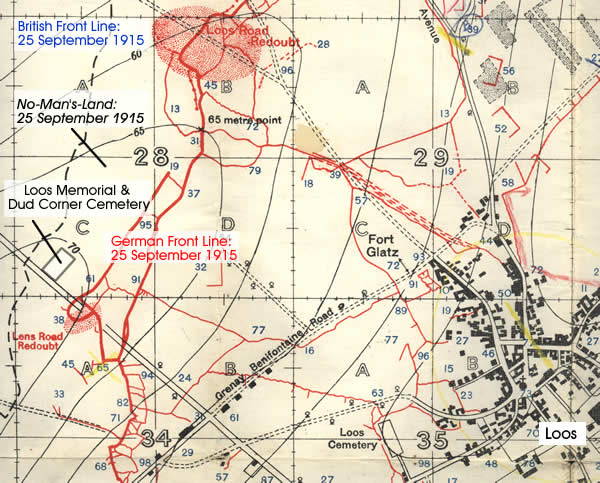
The date of 25 September was the launch of the Allied autumn offensive in a combined attack of British and French troops against the German line in Artois and Champagne. One of the major battles in that offensive was the Battle of Loos (25 September - 13 October 1915), fought by the British First Army under the command of General Douglas Haig in this Lens-La Bassée sector. The launch of the battle at first light on the morning of 25 September witnessed the first use by the British Army of chlorine gas as a cloud of poisonous gas on the battlefield. Earlier in that year the Germans had first tested chlorine gas against the French and British in April and May in the Ypres Salient.
The Missing of the Battle of Loos, 1915
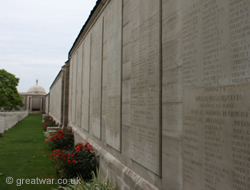
|
Most of the servicemen named on the Loos Memorial fell in action during the Battle of Loos. Many had died in what was to become the new strip of No-Man's-Land between the Front Lines east of Loos by the end of this battle. After the Battle of Loos the Front Lines changed very little in this sector and it was not possible to recover or bury many of the fallen here until the battlefields were cleared from 1919. In that time, the best part of three years, unburied remains would have been subject not only to their natural decomposition, but any means of identifiying an individual from his uniform or kit was exposed to the weather and shellfire.
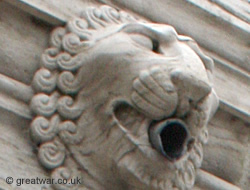
|
Another problem for the later identification of the British dead in this sector, where so many fell in the early few days of the Battle of Loos, was that the majority of British soldiers at this time in 1915 were only issued with one identity disc. British servicemen were not officially issued with two discs until a year later in September 1916. (2) In the Battle of Loos the single identity disc was removed from fallen soldiers on the battlefield in order to establish a figure for the battle casualties. This meant that a later identification of a body would prove to be very difficult, if not impossible. Attempts to retrieve and identify bodies four years later after the Armistice, even if the casualties had been buried in marked plots during the war, was extremely difficult for the burial parties clearing the battlefields. The landscape around Loos looked like a moonscape by late 1918, and very little remained of the original woods, roads or houses to help with orientation for those searching and locating remains on the battlefield.
Casualties in the Battle of Loos
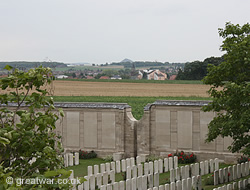
|
In the first hours of the battle the German Front Line at the Lens Road Redoubt was successfully breached by the 15th (Scottish) Division and the Scottish battalions advanced into Loos village. North of the 15th Division the British 1st Division was held up until about 3pm by a gallant stand made by a German battalion commander, Captain Ritter, and a few hundred of his men. With no way out but to sacrifice his men, Captain Ritter eventually decided to surrender in the mid afternoon. The British advance was able to continue north of Loos village.
The German defence of the Front Line at Loos village consisted of one regiment of about 2,800 men, this being the 157 Infanterie-Regiment, and four gun batteries of 233 Field Artillery Regiment. The German defence was overwhelmed and the Germans evacuated the village during the late morning. Moving eastwards to their second line of defence, located on slightly higher ground to the east of Loos and Hulluch villages, the Germans who escaped capture or death reassembled there.
At the end of the morning of 25 September several Scottish battalions from 15th Scottish Division left the eastern exit of Loos village and made their way to the crest of the higher ground south-east of the village. They had seen men running in a south-easterly direction towards the built-up area of Lens and Cité St. Auguste. Mistakenly believing the men to be British they followed on over the crest of Hill 70. The gentle rise in the ground was called Hill 70 on British Army maps because it was on the 70 metres above sea level contour line. From accounts by the German 157th Infantry Regiment it is believed, however, that the men the had seen running were most likely some of the German stragglers evacuating Loos village, including a German battalion commander who ran off in search of a working telephone in Cité St. Auguste.
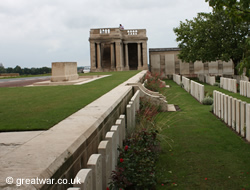
|
A German battalion commander, Major Grause, of the III Battalion 178 Infanterie-Regiment believed that he might be able to prevent Lens from falling into British hands. He was planning an enveloping movement to cut off the Scotsmen who he had seen appearing to his front over the hill at Hill 70. Some Scottish soldiers had advanced over the crest and down the slope to within 100 yards of the German wire at the German Second Position. They had started digging in to the hard chalky soil.
With two companies on his left flank hiding at the bottom of the slope of Hill 70, unseen behind the railway embankment near Fosse 12, Major Grause ordered his right hand two companies to provide supporting fire from the Lens-Hulluch road. At about 1pm, coming under fire from Major Grause's men, a few Scotsmen started to leave what cover they had, crawling at first and then breaking into a run to scramble back up to the crest of Hill 70. The gradual breaking up of this enemy resistance became apparent to Major Grause. In the hopelessness of their situation more and more Scotsmen tried to get back to the crest of the hill over the 600 yards of exposed, bare slope. The Germans down in at the railway embankment at the bottom of the hill spontaneously gave chase. Rushing forward they chased the Scotsmen up the hill shooting and bayonetting. Some stood still to aim fire, picking off the Scotsmen as they were silhouetted on the skyline.
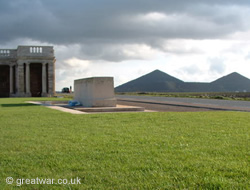
|
The cheers of the two companies of Germans advancing on the left from the railway embankment infected the other two companies on their right at the Lens-Hulluch road. Without orders to do so they rushed wildly forward on a broad front towards the Hill 70 summit. The regimental account describes how German cheers filled the air as they charged forward over the dead and dying Scotsmen. Within an hour, by 2pm, the important task for the III Battalion of 178 Infanterie-Regiment had been accomplished and the high ground of Hill 70 to the north of Lens was again in German hands. For the British, this incident cost many casualties to the 15th Scottish Division, most of whom remained where they fell until the end of the war in what became No-Man's-Land. These soldiers are among the many thousands named on the Loos Memorial to the Missing.
On the second day of the Battle of Loos the casualties were also very heavy for two British Divisions, 21st and 24th Divisions. They had arrived from the reserve positions west of Loos too late to follow up the British successes of the first day of the battle, 25th September. They were put into the fight on the following day, 26 September, crossing open ground towards the higher ground of the German Second Position, which the Germans had reinforced during the night. In addition, four German guards divisions were on their way to arrive in the Second Position by nightfall on 26 September to reinforce this weakened point in the German 6th Army defensive line. The two British divisions went into the attack in daylight, exposed and moving across several hundred metres of open ground. They were cut down by German machine gun and rifle fire. German accounts write of how they watched hundreds of wounded British soldiers trying to crawl back towards the village of Loos during the afternoon and evening.
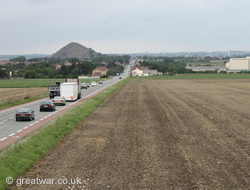
|
A description of the desolate scene was given by Leutnant Aschenbach, observation officer of the 6th gun Battery of the German 233 Feld-Artillerie-Regiment. On 25 September, luckily for him, he was on a day off and was at rest in a village behind the front line. By the end of 26 September he was in a forward observation post about 1 kilometre north of the wood of Bois Hugo. He said he crawled into No-Mans-Land that evening and was confronted with a shocking sight of about 500 British dead piled up in one small area in front of the German wire. He implied they had simply been mown down. He found several dead officers including a white-haired colonel on the wire. He praised the courage of the British commanding officers to have been in the thick of the fight and was deeply moved that so many brave men had lost their lives.
It is possible that the white-haired colonel, whom Aschenbach remembered so vividly, could have been Colonel Frederick Charles Romer, C.B., C.M.G., aged 64 and commanding the 8th battalion the Buffs (East Kent Regiment). He attacked on 26 September in this same place with his men. Colonel Romer was wounded in the shoulder, but insisted on staying with his men in the battle. He was later shot through the heart, dying on the battlefield on 26 September 1915. (3) His remains were never identified for burial in a marked grave. He is named on the Loos Memorial at Panel 15 to 19.
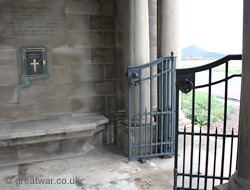
|
Leutnant Aschenbach also recounted a harrowing scene which he witnessed some days after the start of the battle. He wrote that German medics had gone out into No-Man's-Land to pick up British wounded, some of whom had been lying on the battlefield for six days, being very badly wounded and they hadn’t been able to drag themselves back to their own lines. The weather had been bad during that time with lots of heavy rain. They had had no food or drink. Leutnant Aschenbach said he had heard them crying out in No-Man's-Land. In the daylight he watched German medics moving about under cover of a red cross sign. He said that British guns had fired into the area several times forcing the German medics to run for cover, but they were persistent and went out again once darkness had fallen.
Casualties for Scottish Regiments
Of all the regiments listed on the memorial, five Scottish Regiments are the most represented:
- The Black Watch: 829 names
- Cameron Highlanders: 814 names
- Highland Light Infantry: 697 names
- Gordon Highlanders: 678 names
- Kings Own Scottish Borderers: 671 names.
Captain the Honorable Fergus Bowes-Lyon, Black Watch (Royal Highlanders)
One of the names serving with a Scottish regiment and commemorated on the Loos Memorial is Captain the Honorable Fergus Bowes-Lyon. He was serving with the 8th Battalion the Black Watch when he was killed on 27 September 1915, the third day of fighting in the Battle of Loos.
Fergus was the son of the 14th Earl of Strathmore and Kinghorne of Glamis Castle, Forfarshire. At the time he was married to Lady Christian Bowes-Lyon and he was brother to the late Queen Mother. Fergus was educated at Eton and before 1914 he had served with the 2nd Battalion the Black Watch in India. He was aged 26 when he was killed at Loos. Captain Fergus Bowes-Lyon is commemorated on Panels 78-83 for the regiment of the Black Watch.
Lieutenant John Kipling, Irish Guards
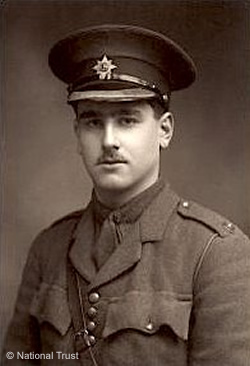
|
John's name was recorded on the Loos Memorial (Panels 9 and 10) for the missing men of the Irish Guards. John Kipling was the only son of the author and poet Rudyard Kipling and his wife Carrie. John was with the 2nd Battalion Irish Guards, promoted to Lieutenant, in the attack on the Chalk Pit north-east of Loos village when he was wounded and missing. His date of death was recorded as 27 September 1915 and the whereabouts of his body was not known to be formally recorded for the family. John turned 18 on 17 August 1915, a few weeks before he died.
After the war John's remains were still officially listed as missing and his father spent many years searching for him and for witnesses who were with him when he was killed. In 1992 the Commonwealth War Graves Commission confirmed that that the unidentified Irish Guards Lieutenant found in 1919 and reburied in St. Marys A.D.S. Cemetery was Lieutenant John Kipling.
For more information about John Kipling's grave follow this link:
The Unidentified Irish Guards Lieutenant at Loos
Design of the Memorial
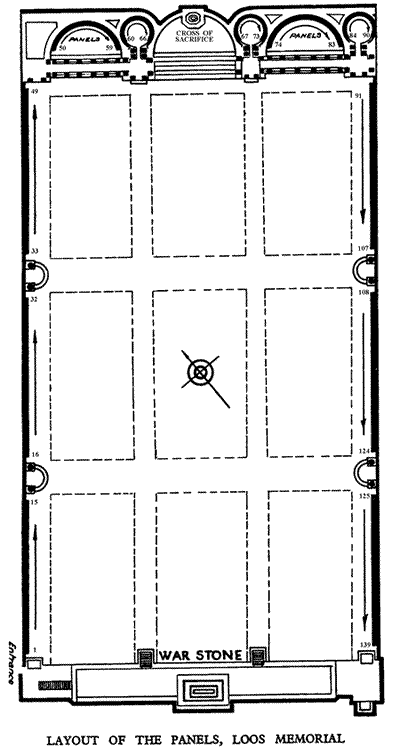
The Loos Memorial was designed by Sir Herbert Baker with sculpture by Charles Wheeler.
On either side of the cemetery the wall is 15 feet high. Stone tablets are fixed to these walls and the names of those who are commemorated on the memorial are carved on these tablets. At the back of the cemetery, the eastern end, there are four small circular courts, open to the sky, in which the tablets are continued. Between these courts are three semicircular apses. The Cross of Sacrifice is located on the centre apse.
At the western end of the cemetery, this being the entrance to the cemetery and memorial, there are two square buildings with crenalations at the top. The right hand building (southern) contains the metal gate into the cemetery and the brass box for the cemetery and memorial registers. The left hand building (northern) has a set of steps to the upper level, which provides a viewing platform for visitors to look over the cemetery and memorial, and to see out across the battlefield of Loos.
The stone tablets containing the names of the missing are numbered from 1 to 139, starting at the north-west corner of the memorial (lower left corner on the plan) and running around the walls to the south-west corner (lower right corner on the plan).
The plan of the memorial is courtesy of the Commonwealth War Graves Commission. (CWGC)
Unveiling of the Memorial
Loos Memorial was unveiled by Sir Nevil Macready on 4 August 1930.
General Sir Nevil Macready, who had the nickname of “Make-Ready”, was the Adjutant-General of the British Expeditionary Force (B.E.F.) when it went to France in August 1914. In early 1916 he took up one of the most senior appointments in the British Army in London as Adjutant-General to the Forces. By 1918 he was promoted to the rank of General. He was further promoted to Knight Grand Cross of St. Michael and St. George, he was a Grand Officer of the Legion d'Honour of France, a member of the order of the Crown of Belgium, the Order of the Crown of Italy and the Order of the Sacred Treasures of Japan. In August 1918 he was made head of the Metropolitan Police in London.
Search for Names on the Loos Memorial
Search the Register held by the Commonwealth War Graves Commission for names of the missing inscribed on the Loos Memorial. You can follow this link and click the See Casualty Records button:
Website: www.cwgc.org Loos Memorial
Loos Memorial Location
The memorial is located on the N943 Lens-Béthune road. It is north west of the village of Loos-en-Gohelle.
Access
The memorial is accessible to the public daily and there are no opening hours.
There is a parking area off the main road at the front of the memorial and cemetery. Visitors are advised to be extremely careful when getting in and out of a car on the side nearest the road. The Lens-Bethune can be busy but even when it is not, vehicles are often travelling at high speed and the tail winds can be dangerous for people moving about around cars parked by the memorial.
Related Topic
The Loos Memorial forms the boundary of Dud Corner Cemetery, resting place of 1,800 officers and men of the British and Commonwealth forces.
Acknowledgements
(1) British Army map 36C N.W. Sheet 3 & Part of 1, trenches corrected to 25 August 1915, scale 1:10,000. Private collection.
(2) The Western Front Association, Article: Identifying the Dead: a Short Study of the Identification Tags of 1914-1918 by David O'Mara
(3) Website: www.kentfallen.com
(CWGC) Cemetery plan by kind permission of the Commonwealth War Graves Commission (CWGC). Website: www.cwgc.org
German Regimental history: Das 233. Feld-Artillerie-Regiment
German Regimental history: Das 4. Schlesische Infanterie-Regiment Nr. 157 im Frieden und im Kriege 1897-1919

